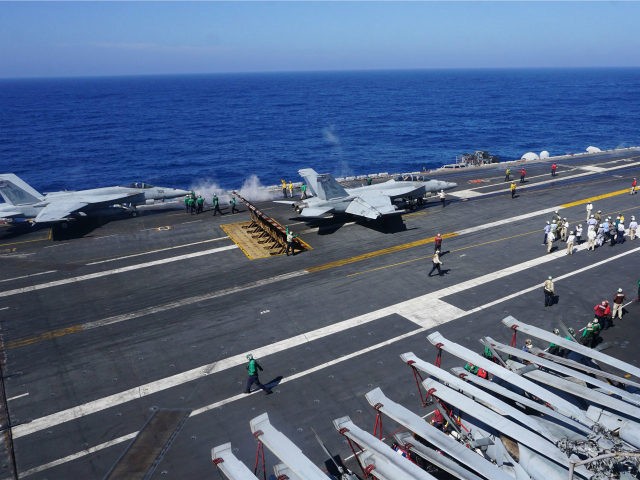The USS Carl Vinson, a massive nuclear-powered aircraft carrier, reportedly sailed deep in the South China Sea amid U.S.-China tensions over Beijing’s territorial disputes with several American allies in the region.
“It shows resolve, and gives decision space to our leaders,” said U.S. Navy Capt. Doug Verissimo, the ship’s commanding officer, referring to the presence of the warship on the South China Sea, the Australian Broadcasting Network (ABC) reported.
The captain noted:
When they put a carrier strike group somewhere it helps to show that the United States is interested. We don’t have a lot of these, so when you put one in a certain area, it has some influence. Of course, it also gives our diplomats time and space to negotiate and make decisions, ultimately to try and prevent any type of armed conflict.
The Filipino newspaper, the Inquirer, recently described the super-carrier as a “floating city,” noting that it houses 72 aircraft, mostly fighter jets, and 5,000 sailors.
Without revealing where exactly the U.S. is planning to sail during its mission, the commander of the Carl Vinson strike group, Rear Adm. John Fuller, added, “I will say our navigation is very good and we know where international law says we can operate and I know where international law says we can’t. And we’re going to do what international law says we can do.”
The top U.S. naval officers’ comments came soon after the chief of U.S. Pacific Command (PACOM), charged with American military activity on the South China Sea, cautioned lawmakers on February 14 that Beijing has already “developed and fielded capability and capacity to challenge our regional maritime dominance.”
Adm. Harry Harris declared that he is “most concerned” about ongoing Chinese military operations in the South China Sea, namely Beijing’s “significant steps to further militarize its bases on disputed features” in the region last year.
According to the top U.S. admiral, China’s “impressive military buildup” may soon enable the People’s Liberation Army (PLA) to challenge America’s military dominance in the Indo-Pacific region.
A few days after making those comments, on February 19, the Inquirer reported that the U.S. had docked the Carl Vinson in Manila for a five-day visit to the region.
The Inquirer noted that “the warship’s deployment in the Western Pacific is a show of presence amid China’s assertiveness in the disputed South China Sea. It came from a routine mission in the hotly-contested waters before its Manila stopover, which began Friday.”
ABC reported that, while the USS Carl Vinson began its journey in Manila, it will also drop anchor in Vietnam, marking the first visit from an American aircraft carrier since the end of the Vietnam War.
China and several Southeast Asian nations, including U.S allies Vietnam and the Philippines, have been engaged in a contest over territorial control in the South China Sea.
Referring to the USS Carl Vinson’s presence off the Philippines, Lt. Cmdr. Tim Hawkins told reporters invited on the American warship by the U.S. embassy:
We have been performing routinely not only in the South China Sea but throughout the Western Pacific to do a few things: to work with our partners and allies, to promote regional security and stability, and reassert our belief that all should operate in accordance with international law, rules, standards, and norms in order to keep the seas free and commerce moving freely.
The commander reportedly said the United States would not be intimidated by China’s militarized islands in the region.
Australia’s ABC news agency pointed out:
The Carl Vinson is the flagship of a strike group from the US Third Fleet. The other vessels are here — but you can’t see them. Somewhere over the horizon, guided missile cruisers and destroyers form a protective shield around the aircraft carrier.
No-one on board will say it so bluntly, but the ship is sailing through the South China Sea to send a deliberate message: these waters aren’t China’s alone.
PACOM is charged with U.S. military activity in 36 nations in the Asia-Pacific region, including Australia.

COMMENTS
Please let us know if you're having issues with commenting.